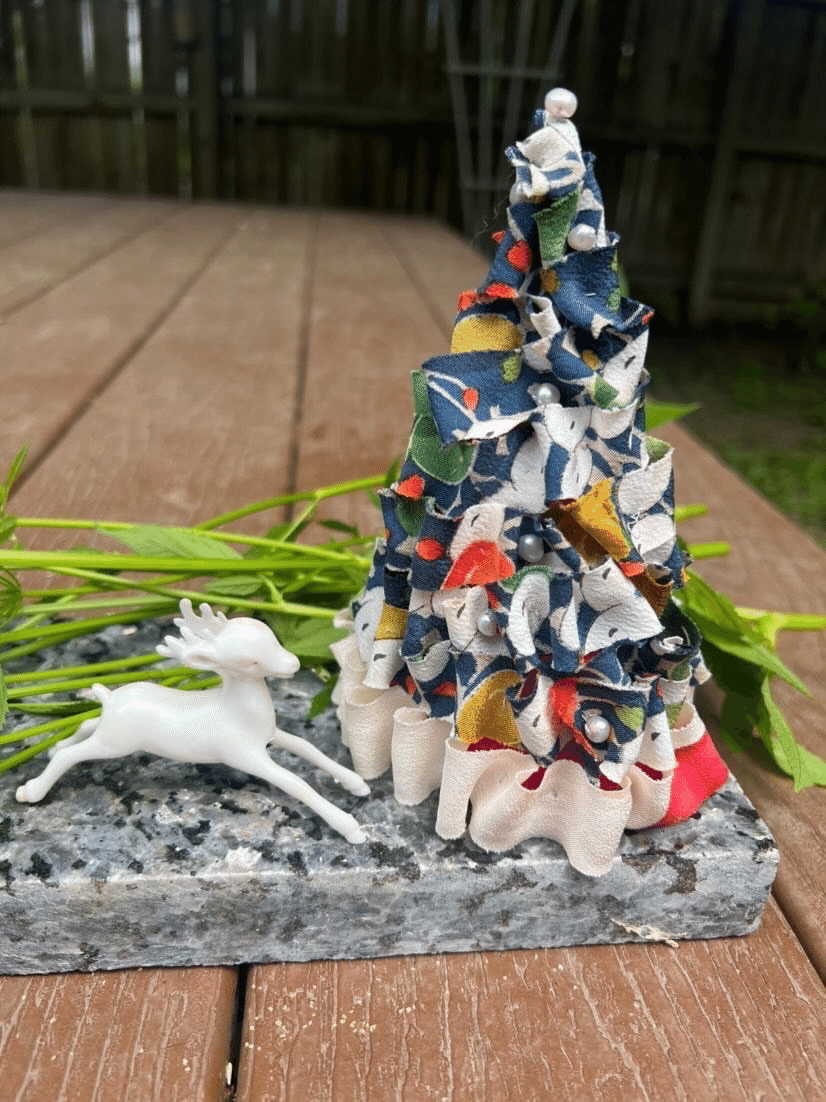
Interviewee:Anne Hamilton 【English version】
Anne is the first handcraft artist who used kimonoyarn in the United States.Gifted with her creativity and artistic mind, she enjoys it very much.We asked her for this interview because we wanted to know what she likes about kimonoyarn and how she saw Japan and Japanese kimono. In the end, she gave a lot of advice regarding what we should do to introduce kimonoyarn to people in the States.
(Interviewer: Seriko Fujieda,Miho Igarashi)
―When did you start handcrafting and what made you interested in it?
(Anne)
I started when I was 4 or 5 years old.The women on both sides of my family were really into making arts and crafts.I was taught at a very early age to make my own clothes and many kinds of crafts. I learned how to use a sewing machine when I was 5. I also learned patterns and embroidery, which I like very much.My mother, my aunts, my grandmother they would make their own clothes and curtains.So, if I wanted something, I would just make it. I used to make candles, too. Now I do a little painting as well. Thanks to such an environment, I grew up with handcrafting.
(Her dog Theodore)
Woof woof!! (means Yes! Yes!)

―What do you make and how often do you make something?
(Anne)
I make something about 2 or 3 times a week at different times of day. I don’t have set hours. When I feel inspired, then I make something.One thing I do every day is to look at materials. I gather materials from all over the world. When they come in, I decide what to make with them.

―What is your favorite material?
(Anne)
Fabrics. I would say Italian fabrics. I grew up with those kinds of things because I am half Italian.I like Italian linen, cotton, and wool.
―What is Italian fabric like?
(Anne)
Well, most of all, it’s natural. Weaves are natural and fine. There is a great deal of pride in tailoring. Some of the wools are thick and very nice. Linen is fine fabric, too. I like the varying thicknesses and the colors are natural. Every time you use them, you have to adjust the setting of the machine. So it’s always a fun experimentation.
―What do you make these days?
(Anne)
Something to place in your house. I found this particular kimonoyarn to be suited for a circular, swirly design.

(Anne)
I added some little freshwater pearls my neighbor gave me on this tree. You can place it in different places at a window or anywhere. This pattern is joyful, very cheerful.

(Anne)
I made this blanket for my friend. I bought a baby blanket and fused the kimonoyarn onto it. I didn’t sew it. So, it’s a nice abstract pattern.

―When you make something, what do you care the most about?
(Anne)
I want to make something that is one of a kind. I’m not a professional artist. I make art for enjoyment. So, I make something that is one of a kind. Also, I think the process is very important. It’s the process of imagining and bringing new ideas. It's very intellectually satisfying. It keeps my mind active. If you engage your mind, you stay young.
(Anne)
I made this brooch with a leftover piece of felt. I made the base and put kimonoyarn on it. Then I embroidered beads on top.

(Anne)
It’s not kimonoyarn but I’ll show you one other thing. A fox. It is made of felt. I worked with a designer. She made the base of it and I put the beads. It took me about four hours or five hours.

―How did you find kimonoyarn?
(Anne)
Instagram! I follow artists who make handcrafts and fabric sellers. It popped up and I thought I had to buy it.
―What do you like about kimonoyarn?
(Anne)
I like patterns. The patterns on the kimonoyarn are just outstanding. The colors and the patterns are unique to Japan. The quality of the silk is amazing. It’s versatile. It brings out your imagination.
―How about the impression of Japan?
(Anne)
I think there is the beautiful simplicity. And there is great sophistication. I like Japanese paper, too. My husband is Korean, so we went to Korea for our honeymoon, and I just got very interested in Korean design and illustration. I’ve been interested in Japanese “washi” paper for a very long time. I collect it. I feel it's a very similar aesthetic to Italian craftsmanship. There's always a striving for an excellent product and a respect for the materials. Kimono is a fine costume as well, with many layers and head dresses...
―Do you have any ideas to make kimonoyarn popular in the US?
(Anne)
Let's see...I think you should introduce yourselves to design schools like Fashion Institute of Technology. I think that if you were to come and do an exhibit here, people would go wild. Maybe there's a Japanese textile exposition that you could come and actually show your work because I think if they see it in person, it will just grab people. California is closer to Japan. Maybe you could start in Los Angeles.
The garment industry is centered in New York City, so there are textile fairs and holiday fairs where you could show your wares. In New York on the holidays, especially at Christmas, everybody is out on the street and they’re going to their markets uptown, downtown, and everywhere. I think you could find many designers and many people who work in the garment industry and personal artists. Oh, there's an entrepreneur who created a Japanese market in Brooklyn. I will find the information and I will send it to you!!
Anne Hamilton
Instagram:@spencerandpoppy

Lives in New York
Her favorite
instagrammer artist/designer/suppliers
@asata.maise
@katiemarievaz
@ceraphic.studio
@beampaints
@windsongwensleydales
@daytonatrim
@ikuntjiartists
この記事が気に入ったらサポートをしてみませんか?
